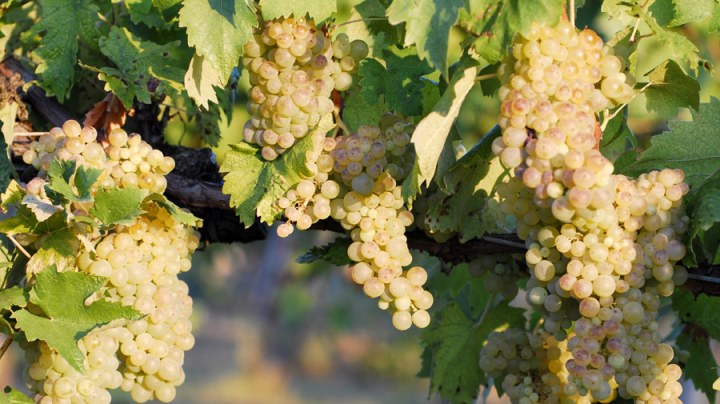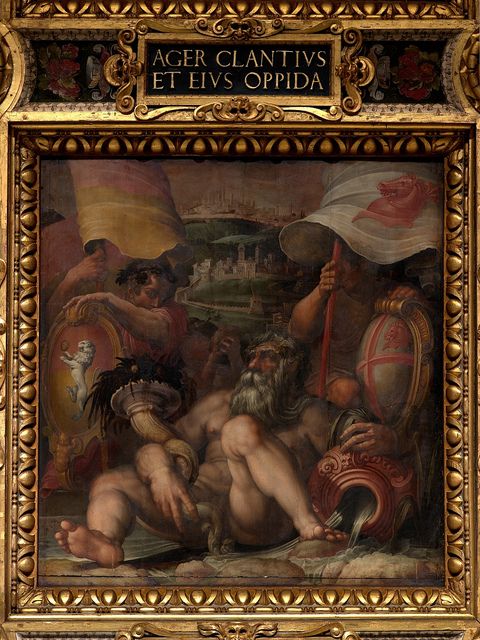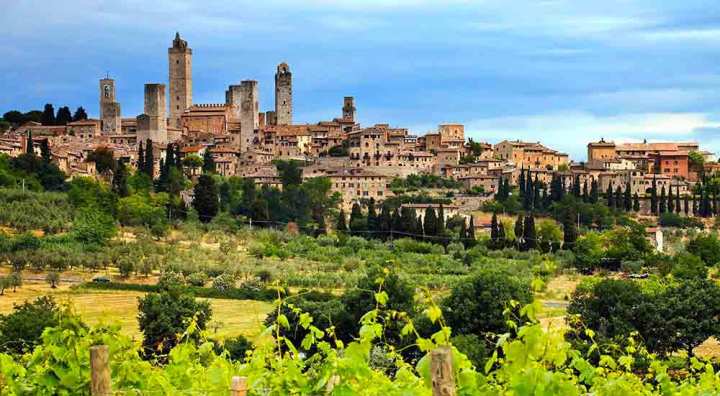It is the wine with the longest history in Italy, more than 8 centuries. Its name is Vernaccia of San Gimignano, which in the 13th century was already the Wine of Kings and Popes.

Since 1285, Vernaccia appears on the texts of european writers and poets, appears on tables of Kings, Popes, Nobles and rich merchants. It was and still is a white wine, but with an intense yellow color, the color of gold! Who knows … it maybe had so big success for its special color so much loved by rich people because recalls royalty and well-being.
The verses of the poet Folgòre from San Gimignano (beginning of 14th century) emphasize the much-appreciated wine:
“Coppe, nappi, bacini d’oro e d’argento / Vin greco di riviera e di vernaccia.”
The origin of the name “Vernaccia”, probably it comes from Vernazza, boarding place of the Ligurian production of wine (Vernazza is a town of “Cinque Terre” in Liguria).
In 1285, Salimbene de Adam describes the wine as a product of “Cinque Terre”, and also many French poets sing about it as the most precious Italian wine. Jeofrois de Wateford and Servais Copal, they write:
“in verità, di tutti i vini è il non plus ultra”
In the 14th century was extraordinarily successful not only on the tables of Lords, many famous writers talk about Vernaccia: from Cecco Angiolieri to Dante, from Boccaccio to Franco Sacchetti, from French Eustache Deschamps and Jean Froissart to the English John Gower and Geoffrey Chaucer. This last one prescribes the Vernaccia to the old Januarie for a good night with the young bride: “He drinkkith ypocras, clarre, and vernage / of spices hote, to encrese his corrage”.

The production of Vernaccia is mainly spread in Tuscany and Liguria, but the next two centuries is already found traces in nearly all Italian wine-making areas. Someone also talk about a black version of Vernaccia, in Calabria, in the Cilento and in Lombardy.
If in the 14th century the most famous was the Vernaccia of Corniglia, during the centuries will be the Vernaccia of Cellatica (Lombardy), Santo Noceto (Calabria) and especially the Vernaccia of San Gimignano to be famous, characterized and well identified with the production territory.
In San Gimignano lands, already famous for the production of saffron, Vernaccia quickly becomes a “rush” product with Greek wine. There are documents of 1321 describing the vineyards: “Narduccio of Saladuccio was buying some pieces of land in the Casale vineyard (…) reserving the vegetable garden and Pastino Vernaccie”.
In the 16th century the production grow further. All important families of San Gimignano and Florence had bought lands and farms in the countryside, implanting new vineyards of Vernaccia. Is a witness, in the years immediately following on 1553 Sante Lancerio, wine manager of Pope Paul III Farnese, who said: “His Holiness in the year 1536 lodged in Poggibonzi, where were very good wines from S. Geminiano (…) also very good vernacciuole (..)”
The 17th century was a “golden” century for Vernaccia of San Gimignano. At the Court of Medici, many Grand Dukes of Tuscany choose the Vernaccia as one of the most important. Giorgio Vasari paints, in the Salone dei Cinquecento in Palazzo Vecchio, the ”Allegory of San Gimignano and Colle Val d’Elsa” (a young satyr drinking Vernaccia).

Almost a century later, in 1643, also Michelangelo Buonarroti writes some verses about Vernaccia ““ma i terrazzani altrui sempre fan guerra / con una traditora lor vernaccia, / che dànno a bere a chiunque vi giugne / e bacia, lecca, morde e picca e pugne” and finally Francesco Redi, in “Bacco in Tuscany” warns: “If there is anyone who does not like / Vernaccia / harvested in Pietrafitta, / interdict / accursed, / run away of my sight”.
In the 18th century the years of the production’s decline coincided with changes in taste. The arrival in Europe of new exotic drinks like tea, coffee, chocolate, and the spread of liquor, previously unknown or used mostly as medicine, creates new lifestyles that relegates the Vernaccia (such as Malvasia and other wines) to margins of the desires of society and markets. However, even if in small quantities, the Vernaccia of San Gimignano continues to be produced.
In the 19th century the production still continues to decline and the grape is spot-located mixed in the vineyard with other Italian grapes. In these years the canonical Ignazio Malenotti, author of a best seller at the time, the “Tuscan winemaker Manual”, confirms this situation accurately describing the traditional ways of the ancient wine making.
At the beginning of the 20th century, while the wave of diseases is radically changing the characteristics of the Italian vineyard, Ugo Nomi Venerosi-Minnows, founder of the Civic Museum and the Library of San Gimignano, notes that Vernaccia “is rare, and land owners keep it just for a personal use, for friends but not for selling”.
In the 21th century, the revival begins in the Thirties (1930-40). Carlo Fregola, Regent of the Itinerant Chair of Agriculture of Colle di Val d’Elsa, is convinced about the good opportunity of replanting the old Vernaccia grape and he finds it, in 1931, hidden in a old vineyard of San Gimignano. “The S. Gimignano farmers must understand the importance of trying to let Vernaccia win back the magnificent image and branding”. But the World War II shut down immediately each renewal ambitions. The process, was however, primed and in the early sixties will start again.

The 60’s marked the rebirth of Vernaccia wine. Recovered the old grape from the confusion of a mixed cultivation, Vernaccia is now replanted in the vineyards according to the new specialized criteria. In 1966 Vernaccia will be the first Italian wine to obtain the DOC (Denomination of Controlled Origin).
In 1972 the creation of the Consorzio della Vernaccia, then transformed in Consorzio della Denominazione San Gimignano, gives new impetus to the production that grows gradually in quantity and quality obtaining in 1993 the DOCG, the highest award of the current Italian wine legislation.

The last twenty years of the ’90s and the beginning of the 2000s are characterized by a further increase in quality, a very good brand awareness and an international export. Vernaccia di San Gimignano is one of the most famous wines in the world along with Chianti (native brother). It’s important to have the knowledge to produce a high quality wine, without ever forgetting tradition and territorial ties.
Sources: Consorzio website www.vernaccia.it, quotes are from the book of Marco Lisi, In the Footsteps of Vernaccia from the thirteenth to twenty-first century, New Image, 2013.

2 pensieri su “Vernaccia, the famous wine of San Gimignano”